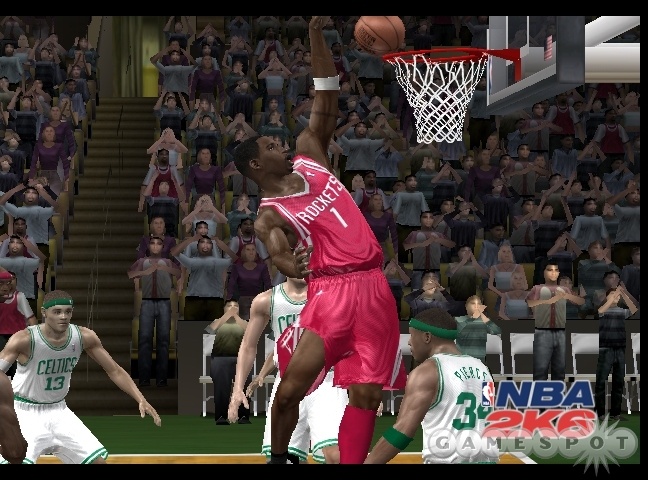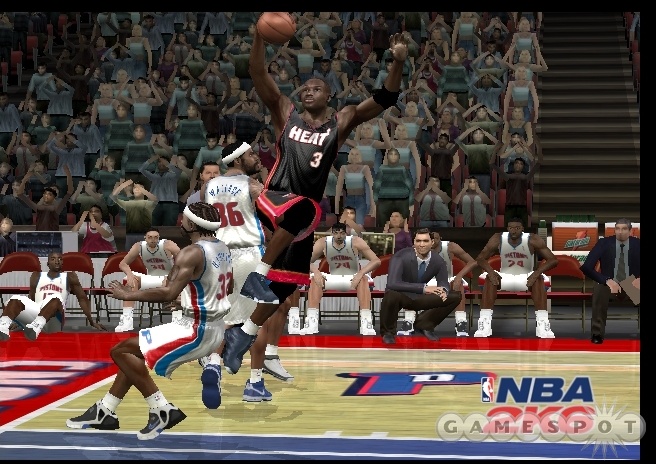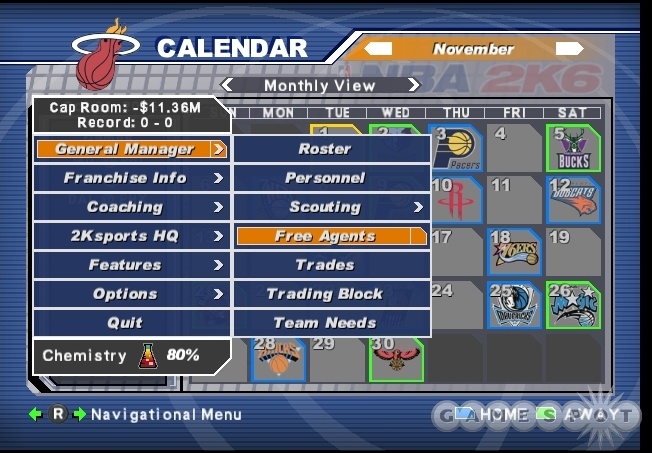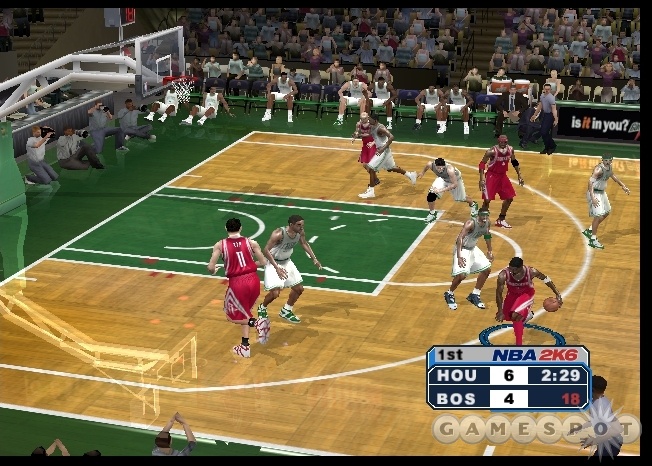Sports games are often knocked for only being evolutionary from year to year. The really jaded among us dismiss the yearly releases of football, basketball, baseball, and hockey games as nothing more than roster updates. The more reasonable among us know that there are only so many ways we can translate the act of throwing a ball into a hoop or striking a ball with a stick. While not quite a revolutionary step, NBA 2K6 did take a big chance with the modifications made to its isomotion juke system and the shot stick control. And, for the most part, the changes turned out to be fantastic. While the tweaks to isomotion and shooting are the most obvious improvements made to an already solid basketball simulation, it's the leaps forward in artificial intelligence that ultimately define NBA 2K6's quality.

As far as presentation goes, NBA 2K6 continues the tradition of fabulous-looking basketball games from Visual Concepts. The accuracy of players' faces is excellent for the most part. Player models are extremely detailed on the Xbox and slightly less so on the PS2. There's little to complain about aside from skin and clothing textures being a little shinier than they need to be. What really makes the game stand out from a visual perspective is the unparalleled wealth of animations used for player movement, collisions, and more. You'll find a ton of flexibility and variety in the way players move and act, whether it's dribbling the ball, defending, rebounding, or even saving a ball from going out of bounds. The animations do pop once in a while, which can be distracting, but overall the fluidity and detail of the player models in NBA 2K6 are fantastic. Unfortunately, on replays the frame rate suffers a lot on both platforms, and the PS2 can get chunky from time to time during regular gameplay. But that's a small price to pay for the overall quality of the game's visuals. The court sounds and crowd noise are as good as ever, and the announcing in the game has improved greatly. Kevin Harlan and Kenny Smith take over for Bill Fitzgerald and Bill Walton from last year's game. Harlan gets overexcited, as he does on TV, but he's still a vast improvement over Fitzgerald. Sure, the soundtrack is forgettable, but getting rid of Walton more than makes up for that. The one thing we're really not sure about is the egregious amount of advertising in the game. Having to see a "Powerbar replay" of all major highlights or the Toyota-branded starting lineups is a lot like TV, but do we need it in the game?
Let's move on to the good stuff. The change made to NBA 2K's isomotion system in 2K6 is likely the most dramatic one you'll notice if you're a veteran of the series. First of all, you no longer have a turbo button in the traditional sense. Instead, the right and left triggers serve as "aggressive modifiers," which change how the game interprets your input with the passing and shooting buttons, and most importantly, with the left analog stick. Instead of wiggling the right analog stick to unleash canned and stilted juke animations, the new isomotion combines your movement and your jukes into the left analog stick. Without holding down any trigger buttons you can simply move the left stick to move your player around. Holding down the aggressive modifier and moving your character in one direction will cause him to sprint. Wiggle back and forth and you'll lower your shoulder and do a crossover. Whirl the stick partway in one direction and then the other, and your ball handler will fake a spin and then come back the other way. Similarly, you can use the left stick plus a trigger button to "emote" wraparound dribbles, jab steps, and step-back moves. Finally, the 2K series has jukes that are just as natural and logical to pull off and chain together as in EA's NBA Live series--isomotion is no longer the redheaded stepchild to freestyle. It's just as good now, and arguably better. How so? Since your right thumb doesn't have to be used to make your juke moves, it's free to shoot or pass right out of your fake. It's a subtle thing, but advanced players will probably appreciate the added flexibility.

So what's the right analog stick used for now? Believe it or not, it's used for shooting. In the same way that basketball video game players have been emoting ballhandling moves for years in most basketball games, the new shot stick feature in NBA 2K6 lets players do the same with their shots. If you stand still and toggle up on the stick, you'll raise up for a standard jumper. Releasing the stick releases the ball, just as if you pressed a shooting button in any basketball game. Toggle away from the basket and your player will put up a fadeaway J. On the dribble drive, you can use the shot stick to attempt a dunk or layup right over the top of a defender, or you can toggle to either side to lean around for a cleaner look at the basket. Out of the post, the shot stick can be used to attempt turnarounds, hook shots, or even drop steps. It takes some getting used to for sure, and when you start, you may even forget to use it (a standard shooting button is still available for those who don't like this feature). But once you do get used to the shot stick, you'll appreciate the flexibility it brings.
The tweaks made to both isomotion and the introduction of the shot stick in NBA 2K6 represent what is probably the biggest fundamental shift in basketball game control mechanics since freestyle control was introduced in NBA Live 2003. These controls are not necessarily easy for a casual fan to pick up, but hardcore hoopsters will definitely feel rewarded for putting in the time to learn them. These interface changes all mesh well with the existing feel and design of the NBA 2K series. Players still move with a real sense of momentum. Aside from some of the backpedaling animation, there's no sense of ice skating at all in the movement. The presence of two pass buttons, both regular and lead passing (throwing a pass to a teammate heading for the basket), also contributes a lot to the game's authentic feel. Rebounding looks and feels right, with little or no "vacuuming" of the ball to the hand. Our only real complaint is that there doesn't seem to be a way to get in a real defensive stance to help stay in front of ball handlers. You really have to pay close attention to keep in front of your man. But if you do, you'll be rewarded with realistic-looking player collisions, and you'll actually be able to steer your man off the direction he wants to move. Defensively, Visual Concepts has added a "strip and rip" steal system using the right analog stick, which lets you poke at the ball with either hand, slap down, or punch upward. This is also hard to get used to, but if you have excellent timing then you'll find that you can strip players just as they go up for a dunk or layup, or punch freshly rebounded balls out of the hands of big men.
Beyond the changes to the interface, one of the biggest improvements made to NBA 2K6 is with its artificial intelligence. If you're a big fan of the NBA, you'll appreciate that the teams and players in NBA 2K6 really do seem to play like their real-life counterparts. Remember how badly Steve Nash and Amare Stoudemire would light up opponents using the high pick and roll? If you don't keep Nash's movement in check, they'll do it to you in 2K6. You'll see Rip Hamilton run through screens and attack off of curls; Dwayne Wade and Shaq will run their inside/outside two-man game; and you'll see Kobe as he tries to take over games by himself. As far as team play goes, you'll notice real nuances here, too. Teams like the Pistons and Spurs really feel like they crash the boards hard with their guards, while running teams such as the Mavs and Suns will often choose to release their guards and look for transition opportunities. The AI in the game is challenging even at the default difficulty. You can still shoot a high percentage, but you'll really need to work hard to find open shots by breaking down the defense off the dribble or by working the ball around, and possibly even dipping into your team's playbook. Playing defense is also a challenge and requires a good amount of concentration, as the computer will look to exploit mismatches or just sloppy, lazy defense. If you don't get a hand in the face of good jump-shooters on every shot attempt, you can expect to get lit up by the likes of Peja Stojakovic or Mike Miller from the arc. You'll also see the computer often isolate its best ball handler on one side, so if you get beaten off the dribble, you'll need to be extra quick with help coming from weak-side rotation.

Aside from the basic gameplay, 2K6 has also greatly overhauled its franchise mode, called Association. Last year's franchise mode gave some interesting ideas, like having meetings with players, and a card-style minigame to simulate individual games. Unfortunately, a lot of these ideas seemed out of place or just didn't work very well, so they've been scrapped entirely. What we've got instead is year-round scouting of prospects. Much like last year's College Hoops 2K5, you can send scouts to evaluate prospects over the course of the year in preparation for the draft. As you reach the offseason, you can bring in these prospects for individual workouts and actually play with them in games or scrimmages to see how they actually feel. There's also a great new system for developing your existing players. By spending training points, you can run your players through a series of drills that are actually minigames. Succeed in the minigame, and your player will gain in skills based on the drill. Put in enough time on a young player with a lot of potential, and he can blossom into a new superstar. Practices no longer weigh down on your team chemistry. You can schedule these on a daily basis in hopes of giving a temporary boost in skill to your team on an upcoming game. However, these practices can also be detrimental to your team's fatigue. Finally, there's a new system where the game's various owners are modeled. You must attempt to run the franchise to their specifications, whether it's winning a championship, being profitable, or just improving the team. A new nested menu interface also makes navigation easier this year. If there's anything to complain about, it's that there might actually be too much going on with Association. But, thankfully, most of these little details don't need to be handled manually.
The 24/7 mode has also been addressed this year, and it's now tied into the real-life EBC, or Entertainer's Basketball Challenge. At the heart of it, though, it's still a basketball RPG and it still involves a lot of work to create your player and to improve his skill by playing in various challenges against a ladder of real NBA players and celebrities. You'll earn new teammates and points that you can use to buy gear, like Nike shoes and clothes. The ultimate goal is to build up the best possible team to go into the EBC tournament at Rucker Park and win it. In the end, though, the overall feel and design of 24/7 is still the same. Some people are going to be really into putting time in a created baller and leveling him up. Most people will probably pass over this mode and see it as just a distraction from the real meat of NBA 2K6.

Other features in NBA 2K6 include the usual tournament, season, and street modes, where you can play street-style games like two on two, three on three, or 21 in various real-life and fantasy blacktop courts using NBA players. The crib is also back, and it gives you something semi-interesting to do with all those points you're earning by playing games of NBA 2K6. What's more noteworthy is that the VIP system popularized in the NFL 2K games has made its way into NBA 2K6. As with the NFL VIPs, here you can examine these and learn a wealth of stats about your own playing tendencies and trade them around with your friends. The online functionality of NBA 2K6 is about what you'd expect. You can get online with either the PS2 or Xbox versions and open yourself up to quick matches, tournaments, leaderboards, and leagues. You can also try setting up street mode games. Our testing on prerelease servers was mostly positive, with smooth gameplay and little latency to speak of on good connections.
NBA 2K6 isn't for the casual basketball fan who doesn't know a pick and roll from picking his nose. The difficulty of the game, and new interface nuances, may be a little overwhelming for someone who's more attuned to something like NBA Jam or NBA Street. But for those looking for a quality simulation basketball experience, NBA 2K6 is a resounding slam dunk and is easily recommendable to any fan of the series or to any hardcore basketball fan in general.



